
Unitsky String Technologies


 |
Unitsky String Technologies |


|
Site news
|
7 November 2015 |
|
Goals and objectives of SkyWay project The goals and objectives of the SkyWay project take their origin in the history of this technology creation - about 50 years ago, in the distant Soviet past. When a schoolboy, living in Jezkazgan near Baikonur, being fascinated by missile simulation, I realized the shortcomings of the booster. Its efficiency ratio is less than 1 percent (today's steam engine efficiency ratio is 15%). Each rocket launch makes a hole in the ozone layer of the planet the size of France. Capacity of heavy missile engines is 100 million horsepower (just imagine a herd of 100 million horses!). And all this power is emitted in an extremely vulnerable ozone layer of the planet as a chemically active flame having the exhaust velocity of 4 kilometers per second (the speed of the fastest bullet is by five times less) at the temperature of 4 thousand degrees (the melting point of steel is 3 times lower). 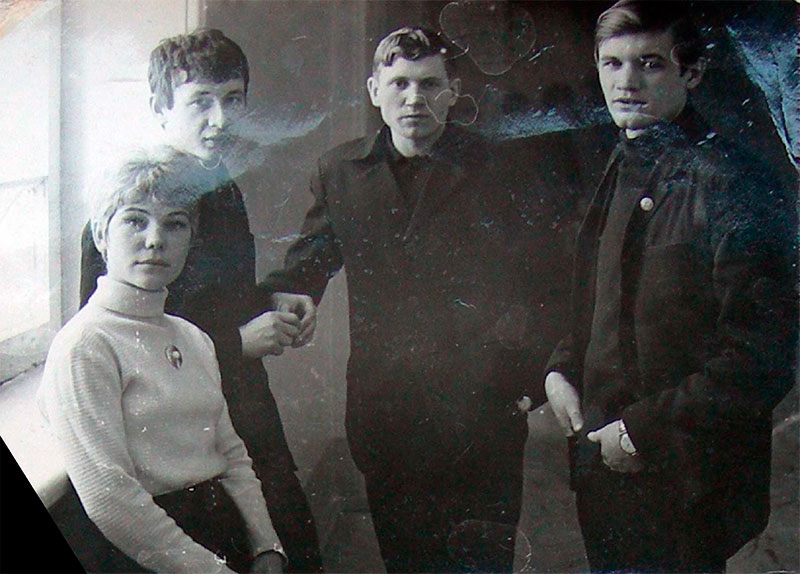
1971. Anatoly Yunitskiy (second from the left) - a student of the Tyumen engineering and construction Institute. 60 U.S. Shuttle launches per year will lead to complete destruction of the ozone layer of the planet, therefore Americans did not do more than 10 launches each year. Some rocket fuels, as, for example, heptyl in the Russian "Proton", are more poisonous than potassium cyanide, and filling of one of these rockets needs about 600 tons of fuel or 600 million grams. This poison (fuel of just one rocket with a payload capacity of only 6 tons) is enough to kill all the humanity - all 7 billion people. I also realized that a rocket is just a vehicle that will not provide for the creation of the space industry of the future and the salvation of the biosphere. The biosphere will be inevitably destroyed by the techno-sphere, which our rapidly growing technocratic civilization creates and develops on the planet. In the future no one would be able to sit peacefully somewhere on the Riviera or on a private island in the ocean. 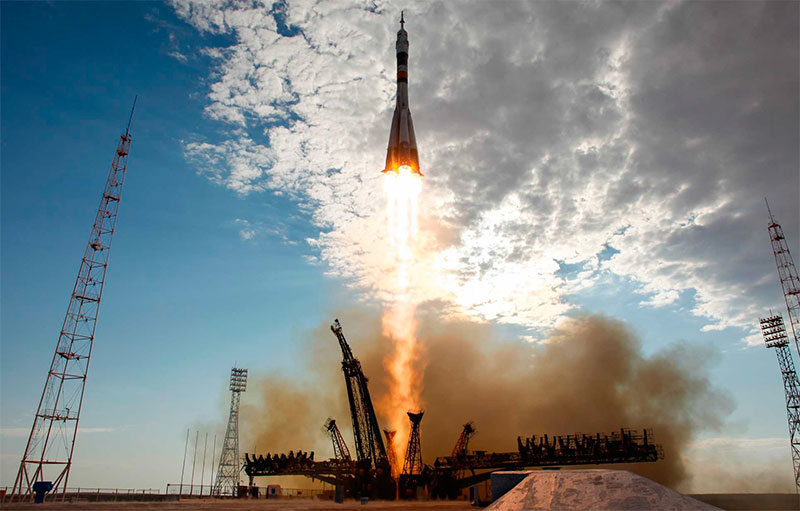
I also realized that a rocket is just a vehicle that will not provide for the creation of the space industry of the future and the salvation of the biosphere. The biosphere will be inevitably destroyed by the techno-sphere, which our rapidly growing technocratic civilization creates and develops on the planet. In the future no one would be able to sit peacefully somewhere on the Riviera or on a private island in the ocean. Primitive people, burning fires in their homes, in a cave, died from lung cancer at the age of 20. Then they decided to take technologies outside their homes and were able to survive. Now the entire biosphere of the planet is our home. So that we might all survive tomorrow, it will be necessary in the future to remove the environmentally hazardous part of the earth industry outside of the biosphere, in the near space. I realized it about 40 years ago. We have 3-4 generations, i.e. 60-80 years left to the no-return point when the end of our civilization will become apparent and tangible by all, including politicians who today govern this process reaching for our end. And it does not matter whether they realize it today or not. We, or rather our descendants, will not feel easier from it. Paraphrasing Zhvanetskiy, you can say: "Whatever you do with civilization - it persistently creeps to a cemetery". I found the technical solution to a non-rocket industrialization of space, became a member of the Federation of cosmonautics of the USSR, organized and hosted the First international conference on rocket-free space exploration, has published a number of scientific papers and monographs. The USSR State Cinema Committee even made about it a popular scientific film of 30-minutes "To the sky by wheel", which was shown on the screens of the USSR and abroad 26 years ago in 1989. 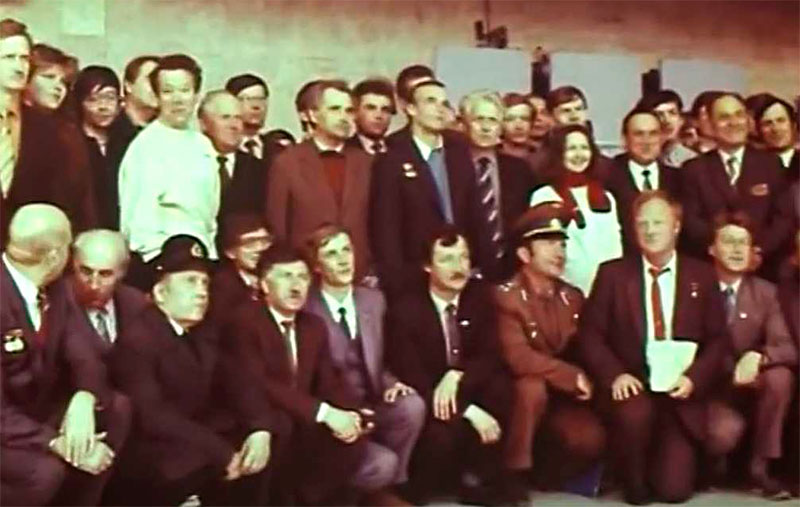
City of Gomel, April 1988. The first scientific and technical conference "Rocket-free industrialization of space: At about the same time, in the late sixties, while studying at the Tyumen engineering and construction Institute on specialty "engineer of railways", I was seriously engaged in the analysis of surface transportation. In this case, I reasoned as follows: "I know nothing about transport. I only know the laws of physics of our real world in which we live. And how could I design an optimal ground transportation on this basis?" I thought simply on the basis of school physics course. For example, I got from Tyumen to Moscow by some transport: by bike, by car, train, plane or rocket. What will be the efficiency of transport work? In Tyumen I was at an altitude of 100 meters above sea level, in Moscow it is also at the height of 100 meters. So my potential energy, as cargo, equal to mgH, has not changed. In Tyumen my speed relatively to the earth surface is zero, since I was motionless; in Moscow it is also equal to zero, since after the arrival, at the airport, I am also motionless. So my kinetic energy as a cargo, equal to mv2/2, has not changed either. In this case, the movement of each passenger from Tyumen to Moscow will require a lot of energy, if converted to fuel - about 100 liters. That is, the fuel spent will weigh more than the transported cargo - a passenger. From the point of view of physics, the useful transportation work in this case is equal to zero, because after the transportation, the energy state of the load has not changed. Therefore, if you divide zero (useful work) by "E" (energy spent), we shall receive zero. This is the efficiency ratio of any ground transportation system - it is always equal to zero. And zero, which is obvious, cannot be improved. Then I started to think further. If zero cannot be improved, then what for was the energy on my movement on the surface of the earth wasted? It turns out that 100 percent of the energy is spent not for a useful work, but for the struggle with the environment and its destruction. That's what we call the ecology. This is manifested in the emission of exhaust gases, noise at rolling stock movement, in the vibration of the earth, abrasion of tires, asphalt, rails and crushed stone cushion and so on. So, for ground transport it is necessary to minimize the suppression of the surrounding environment and its destruction. I was mostly interested in the high-speed traffic, since we live in a world of increasingly high speeds. But since we do not live on the Moon, where there is vacuum, but on the Earth, where there is atmosphere, I was interested in aerodynamics, or rather the aerodynamic drag to high-speed movement. The formula of aerodynamic drag power was simple. This power is proportional to air density, cross-sectional area of the vehicle body (the so-called midsection), the aerodynamic drag coefficient Cx and the speed of movement. The speed in the formula is cubed. What does this mean? For example, if we are moving in a car at the speed of 100 km per hour and the motor spends on aerodynamics 20 horsepower, this is little energy - about 4 liters of fuel per hour of motor operation. Now let's increase the speed of the vehicle up to 500 km per hour. Speed is increased by 5 times. We raise 5 to the third power. We get 125 times - the strength of aerodynamic drag increased by so many times. We multiply 20 horsepower by 125 and get 2,500 horsepower, which is the capacity of 5 tank engines. Such motor will spent on aerodynamics 500 liters of fuel an hour instead of 4 liters at the speed of 100 km per hour. Thus, to increase the speed by 5 times it is necessary to increase the motor capacity by 125 times. That is why one of the most expensive and fastest commercial car "Bugatti" has the motor capacity of 1,500 horsepower that allows it to reach a maximum speed up to 430 km per hour. It turns out that when moving in air with high speed, 90% or more of the drive power of a vehicle is spent on overcoming aerodynamic drag. Therefore aerodynamics is the most important and the most significant science here. Further researches allowed to find solutions to improve high-speed aerodynamics by 5 times in comparison with "Bugatti". "Bugatti" has Cx=0.38, unibus has Cx=0.075, that is 5 times less. "Bugatti" carries 2-3 passengers and unibus - 20-30 people. These results were obtained experimentally, by repeated blowdowns in a wind tunnel and patented. With half of the improvement achieved by eliminating the screen effect, a rail car, called by me later "unibus", does not move on a continuous roadbed, but on two thin string rails. Now I am planning to improve Cx by 1.5 times - down to the value of 0.05, which is close to the theoretical limit equal to 0.04. 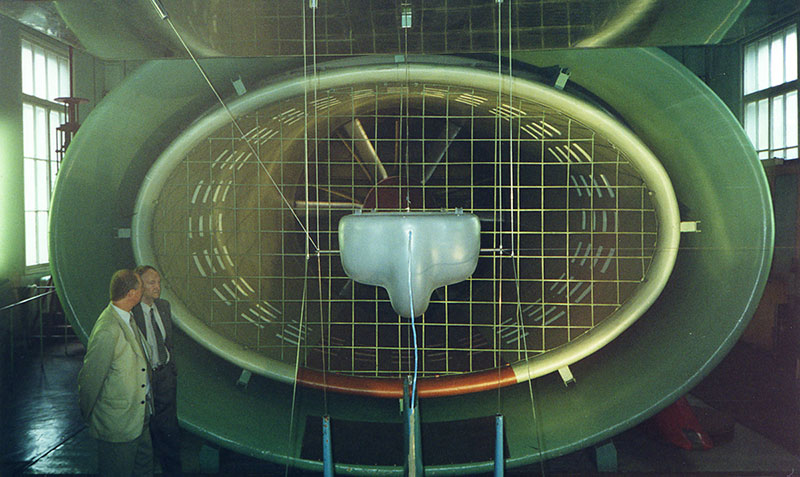
Aerodynamic tests of the SkyWay high-speed (up to 500 km/h) rolling stock (scale 1:5) in a wind tunnel of the Krylov Central scientific and research institute (St. Petersburg), 1995-2001. If 9/10 of energy is spent for aerodynamics during high-speed motion, where does the remaining 1/10 go? It turns out - on the suspension relatively to the track structure. I had to study and explore different suspension systems - magnetic and air cushion, and the traditional wheel both as a pneumatic tire and a steel wheel. It turned out that the most inefficient system is the air cushion. No better is the magnetic cushion. For example, in the transport system "Transrapid", developed by "Siemens" and implemented in a single project "Shanghai - Airport", the total coefficient of performance of magnetic suspension and linear motor does not hold up to 15 percent. This means that the efficiency of the "Transrapid" drive system is lower than the efficiency of a modern steam engine - a synonym of energy inefficiency. It turned out that the most effective suspension system is the "Steel wheel - Steel rail" with the efficiency rate of 99.8%, as a force of about 2 kg can move along a horizontal rail track a bogey weighing 1 ton. Losses are an order of magnitude less, and at high speeds - by 2 orders of magnitude less than that of the system "Pneumatic tire - Asphalt-concrete roadbed". The "Bugatti" at high speed spends on the wheels about 500 horsepower of capacity, or 100 liters of fuel per hour. If it had steel wheels, it would spend on them only 10 horsepower and 2 liter of fuel per hour. Then I had to improve the steel wheel, too, - in a unibus it is 2 times more effective than in the traditional railway wheel pair, therefore the "Bugatti" on our steel wheels would spend only 5 horsepower and 1 liter of fuel per hour to overcome the resistance to wheel rolling. 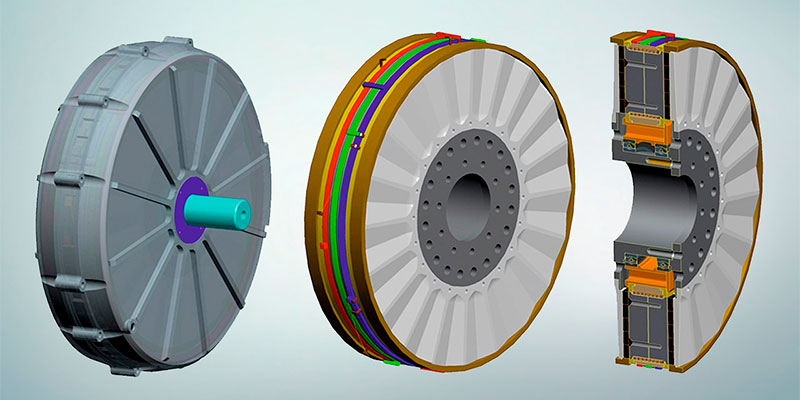
Motor-wheel of unibus The energy consumption for movement is operating costs that must be borne every second, every minute, every hour, every day, every year and every century. For example, the TRANS-Siberian railway exists for more than 100 years and trains constantly and inefficiently spend energy to move billions of tons of cargo for thousands of kilometers. And additionally there are capital costs for the construction of the transport system. Any road can be built in three versions:
The cheapest option - on earth embankment - is the most environmentally hazardous. Embankments destroy soil. In the world today the area of land "rolled" in the asphalt is larger than the territory of the UK by more than 5 times. This land is dead - it does not grow vegetation, which produces oxygen needed for life on the planet, including our breathing. An earthen mound, in which the soil is compacted by 10 percent in comparison with the natural condition, is a low-pressure dam, which cuts of the sources of rivers, the movement of ground and surface waters. This leads to swamping on one side of the mound and desertification on the other. Therefore, we often see withered trees and even entire forests of dried wood next to the road. Embankment cuts the migration routes of animals and interfere with agricultural activities. Underground tunnels are very expensive - today, laying of one kilometer of transport tunnel costs hundreds of millions of dollars or even a billion dollars. A passenger feels uncomfortable in the tunnel - we are not underground inhabitants, and it is dangerous to life, too. It is already studied that, for example, in the Moscow metro a person can be safe only the first 3 seconds. The station begins to destroy our body the rest of the time - insulated and compressed space, a lot of noise and vibration, strong electromagnetic fields and other unnatural impacts are very harmful to humans. Then there is the elevated overpass left. But it has a high material consumption of dozens of tons of steel and concrete per meter and, consequently, high cost - 100 million USD per kilometer and more. However, if we remove the solid roadbed and leave only narrow strips for driving wheels, then we shall reduce the cost of span structure by the order of magnitude. And if we make the design uncut along the length of the track, without expansion joints, we will increase the carrying capacity of such overpass twice. Besides, to prevent compression and buckling, the track structure must be stretched in the longitudinal direction, that is it must be made pre-stressed. So, the idea of a string rail was formed, which then, in a quarter of a century, has been tested on the test facility in the town of Ozyory, Moscow region. With the weight of the track structure 120 kg per linear meter only, requirements to the string-rail span of 48 meter length was 2-fold tighter than to a capital bridge - a military truck ZIL-131 with a 15 ton weight sagged the track structure with its motion by 30 mm only. It is 1600-th part of the length of the span, while the permissible relative stiffness of major bridges is 1:800. 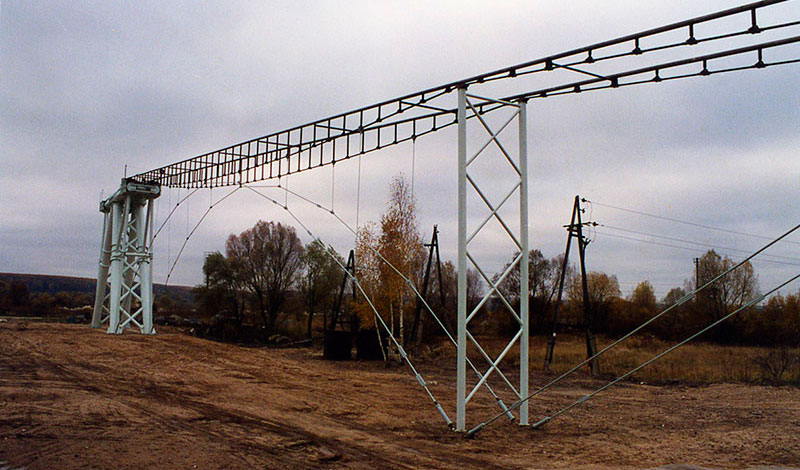
First tests of 150 meter track structure at the UST test site were held in October 2001 in the town of Ozyory, Moscow region 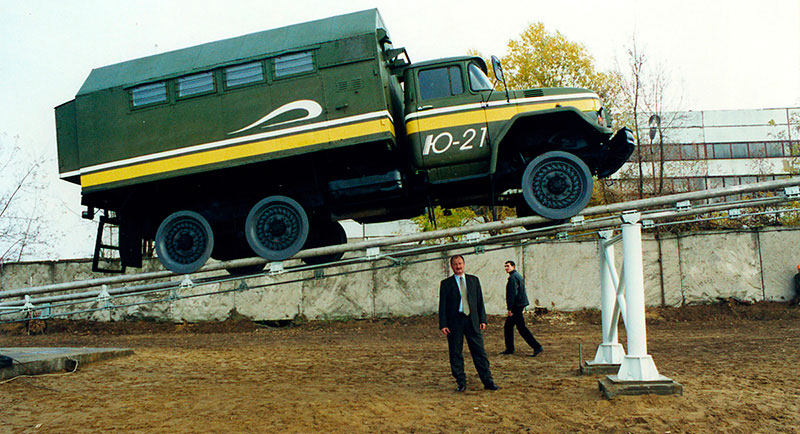
Anatoly Yunitskiy demonstrates viability of track structure standing under a 15 ton truck ZIL-131 And it turned out that when the support top is attached to the continuous track structure, its load bearing ability increases by 8 times. So, supports will be dozens of times cheaper, as in addition to it, weight load from a light trestle will be much less than in traditional girder bridges. Thus created was the concept of optimal elevated transport system, later called SkyWay. The main elements of such a track are:
As a socially oriented person, I always wondered what my inventions would bring to humanity not only now but in the distant future, too. Here are some figures. Over the last 100 years nearly 40 million kilometers of roads were built throughout the world - motor roads and railways. If they are replaced with the Transnet transport and communication network, built by the SkyWay technologies, it will bring about the following socio-economic effect for the planet and all humanity:
The car turned out to be much more dangerous than a Kalashnikov rifle and a nuclear bomb. Socio-economic effect in this index will exceed 500 trillion dollars. The socio-economic effect in this index will exceed 100 trillion dollars. These savings are the total production of these resources by all of the earth's industry for 100 years. The socio-economic effect in this index will exceed 1,000 trillion dollars. The socio-economic effect in this index will exceed 1,000 trillion dollars. There are also additional advantages of the SkyWay technology on the global Transnet track network, the socio-economic effect of which exceeds trillions of dollars:
Thus, the total socio-economic effect from the creation of the global Transnet track network will exceed 5,000 trillion dollars in the 21st century. This project is vital for our civilization and our planet. 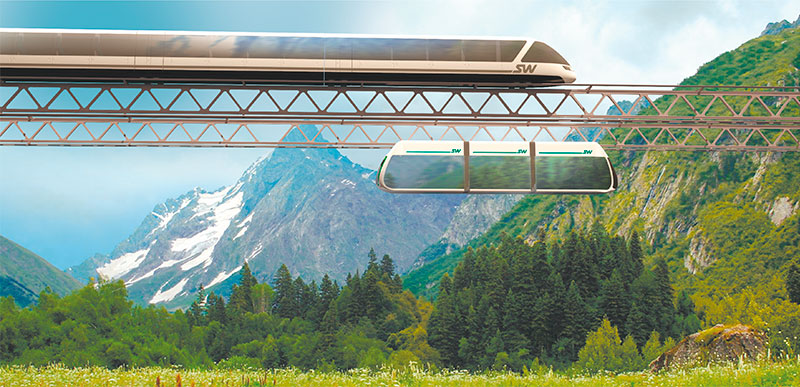
Therefore, the strategic objective of the SkyWay program is the creation of Transnet track network of the length about 50 million kilometers on the planet in the 21st century. Socio-economic effect for the civilization from the implementation of such large-scale and ambitious project, as I already noted, will exceed 5,000 trillion dollars. We approach this purpose sequentially, step by step:
Today we have a portfolio of orders for 100 billion USD. After attending our salon of SkyWay technology sales in 1 year in Belarus, customers will sign contracts, no doubt. And 5 percent advance payments, i.e. 5 billion dollars, will pay back practically in one day 10 times the investments of 500 million USD - previous and current. We will enter the IPO. Our shares will be worth at face value. Thousands of our shareholders will become dollar millionaires and more than 10 - even billionaires. I will be among them, too. Then I want to invest all of my personally earned money in the development of the space program Space Way. Nobody is ready to finance this program today, - neither Russia with its Roscosmos nor the United States of America with their NASA, nor the United Nations. Only research and development work under this program will require about 100 billion USD of investments. The implementation of the program Space Way, the cost of which is estimated at a trillion dollars, will ensure the transition of earth civilization to a new stage of development. It will become a space civilization, where industry will be located outside of its home - the planet Earth. 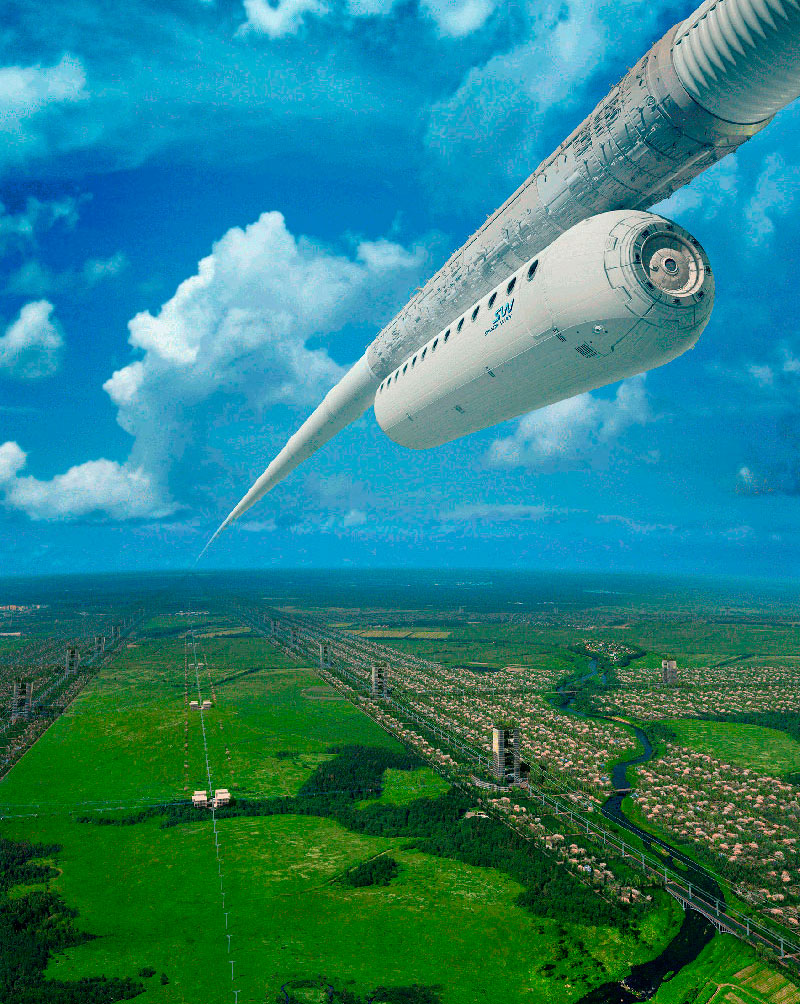
Space SkyWay Our civilization and our grandchildren will acquire limitless possibilities for further technological development without conflicts between the terrestrial biosphere, created by God, and industrial technosphere, created by Homo sapiens. And there is another point of concern to me since childhood. I knew that we were not alone in the Universe. That there are civilizations that are ahead of us in development by millions of years. Why don't they get in contact with us and help us in development? Now I have the answer to this question. It is impossible to get in contact with the savages - what can you discuss with the civilization that is war-torn, which swings missile and nuclear clubs, and spends annually trillions of dollars just to kill each other? We are not ready to make contact, not them. However, when the Space Way program will be embodied on the planet Earth, we shall become a space civilization. This program can be implemented only by the power of all humankind. For this all countries must stop wars, unite the scientific, economic and production capabilities and jointly remove into space all the noxious industry - metallurgy and chemical production, energy and mining industry and so on. And leave on the Earth only fields, forests, meadows, clean rivers, seas and clean air. That is when our civilization will be included in the space club, and other civilizations will come into contact with us. The civilizations that have passed a similar stage in their development on their planets. That is why my motto is: "Build SkyWay - save the planet". |
|
© 1977—2017 Anatoly Yunitskiy. All Rights Reserved. |
||